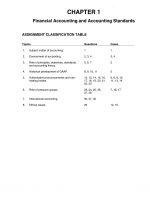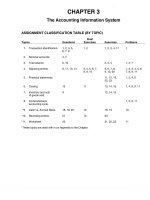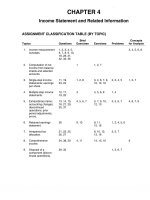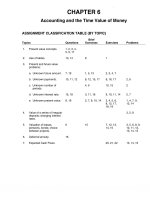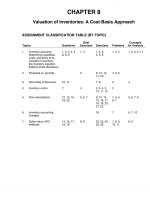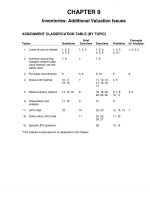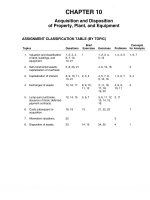Solution manual intermediate accounting 14e kieso weygandt warfield ch20
Bạn đang xem bản rút gọn của tài liệu. Xem và tải ngay bản đầy đủ của tài liệu tại đây (407.34 KB, 104 trang )
CHAPTER 20
Accounting for Pensions and Postretirement Benefits
ASSIGNMENT CLASSIFICATION TABLE (BY TOPIC)
Topics
1. Basic definitions and
concepts related to
pension plans.
Brief
Questions Exercises Exercises
1, 2, 3, 4,
5, 6, 7,
8, 9, 12,
24, 30
2. Worksheet preparation.
Problems
16
Concepts
for Analysis
1, 2, 3,
4, 5, 7
3
3, 4, 7, 10,
14, 15, 18
1, 2, 4, 7, 8, 9,
10, 11, 12
1, 2, 4
1, 2, 3, 6,
11, 13, 14,
15, 16,
17, 18
1, 2, 3, 4, 5,
6, 9, 11, 12
4. Balance sheet recognition, 15, 19, 20,
computation of pension
22, 23
expense.
6, 10
3, 9, 11, 12, 1, 2, 3, 4,
13, 14
5, 6, 7, 8,
9, 11, 12
2, 5, 7
5. Corridor calculation.
18
7
8, 13, 14,
16, 17, 18
2, 3, 5, 6, 7,
8, 11, 12
3, 4, 5, 6
6. Prior service cost.
12, 13, 20
5, 6, 8
1, 2, 3, 5,
9, 11, 12,
13, 14
1, 2, 3, 4,
6, 7, 8, 9,
11, 12
1, 4
7. Gains and losses.
14, 17,
21, 22
7, 9
8, 9, 13, 14, 1, 2, 3, 4, 5, 6,
16, 17
7, 8, 9, 11, 12
4, 5, 6
8. Disclosure issues.
23
10
9, 11, 12
11, 12
3, 4
9. Special Issues.
25
11, 12
19, 20, 21,
22, 23, 24
13, 14
3. Income statement
recognition, computation
of pension expense.
*10. Postretirement benefits.
9, 10, 11,
13, 16, 17
26, 27,
28, 29
4, 5
*This material is dealt with in an Appendix to the chapter.
Copyright © 2011 John Wiley & Sons, Inc. Kieso, Intermediate Accounting, 14/e, Solutions Manual (For Instructor Use Only)
20-1
ASSIGNMENT CLASSIFICATION TABLE (BY LEARNING OBJECTIVE)
Learning Objectives
Brief
Exercises
Exercises
Problems
1.
Distinguish between accounting for the
employer’s pension plan and accounting
for the pension fund.
2.
Identify types of pension plans and their
characteristics.
3.
Explain alternative measures for valuing the
pension obligation.
4.
List the components of pension expense.
1, 2, 4
1, 2, 6, 11,
12, 13, 15
5.
Use a worksheet for employer’s pension plan
entries.
3
3, 4, 7, 10,
11, 14, 18
1, 2, 4, 7,
8, 9, 10,
11, 12
6.
Describe the amortization of prior service costs.
5
1, 2, 5, 7,
12, 13
1, 2, 3, 4,
6, 7, 8, 9,
10, 11, 12
7.
Explain the accounting for unexpected gains and
losses.
12, 13
1, 2, 3, 4,
5, 6, 7, 8, 9,
10, 11, 12
8.
Explain the corridor approach to amortizing gains
and losses.
7
8, 12, 13,
16, 17, 18
3, 4, 5, 6,
8, 11, 12
9.
Describe the requirements for reporting pension
plans in financial statements.
6, 8, 9, 10
9, 11,12, 13
1, 2, 3, 4,
8, 11, 12
*10.
Identify the differences between pensions and
postretirement healthcare benefits.
11, 12
19, 20, 21,
22, 23, 24
13, 14
*11.
Contrast accounting for pensions to accounting
for other postretirement benefits.
11, 12
19, 20, 21,
22, 23, 24
13, 14
20-2
Copyright © 2011 John Wiley & Sons, Inc. Kieso, Intermediate Accounting, 14/e, Solutions Manual (For Instructor Use Only)
ASSIGNMENT CHARACTERISTICS TABLE
Item
E20-1
E20-2
E20-3
E20-4
E20-5
E20-6
E20-7
E20-8
E20-9
E20-10
E20-11
E20-12
E20-13
E20-14
E20-15
E20-16
E20-17
E20-18
*E20-19
*E20-20
*E20-21
*E20-22
*E20-23
*E20-24
P20-1
P20-2
P20-3
P20-4
P20-5
P20-6
P20-7
P20-8
P20-9
P20-10
P20-11
P20-12
*P20-13
*P20-14
Description
Pension expense, journal entries.
Computation of pension expense.
Preparation of pension worksheet.
Basic pension worksheet.
Application of years-of-service method.
Computation of actual return.
Basic pension worksheet.
Application of the corridor approach.
Disclosures: Pension expense and other comprehensive income.
Pension worksheet.
Pension expense, journal entries, statement presentation.
Pension expense, journal entries, statement presentation.
Computation of actual return, gains and losses, corridor test, and
pension expense.
Worksheet for E20-13.
Pension expense, journal entries.
Amortization of accumulated OCI (G/L), corridor approach,
pension expense computation.
Amortization of accumulated OCI balances.
Pension worksheet—missing amounts.
Postretirement benefit expense computation.
Postretirement benefit worksheet.
Postretirement benefit expense computation.
Postretirement benefit expense computation.
Postretirement benefit worksheet.
Postretirement benefit worksheet—missing amounts.
2-year worksheet.
3-year worksheet, journal entries, and reporting.
Pension expense, journal entries, amortization of loss.
Pension expense, journal entries for 2 years.
Computation of pension expense, amortization of net gain or
loss-corridor approach, journal entries for 3 years.
Computation of prior service cost amortization, pension
expense, journal entries, and net gain or loss.
Pension worksheet.
Comprehensive 2-year worksheet.
Comprehensive 2-year worksheet.
Pension worksheet—missing amounts.
Pension worksheet.
Pension worksheet.
Postretirement benefit worksheet.
Postretirement benefit worksheet—2 years.
Level of
Time
Difficulty (minutes)
Simple
15–20
Simple
10–15
Moderate
15–25
Simple
10–15
Moderate
15–25
Simple
10–15
Moderate
15–25
Moderate
20–25
Moderate
25–35
Moderate
20–25
Moderate
20–30
Moderate
20–30
Complex
35–45
Complex
Moderate
Moderate
40–50
15–20
25–35
Moderate
Moderate
Moderate
Moderate
Simple
Simple
Moderate
Moderate
30–40
20–25
5–10
25–30
10–12
10–12
15–20
25–30
Moderate
Complex
Complex
Moderate
Complex
40–50
45–55
40–50
30–40
45–55
Complex
45–60
Moderate
Complex
Moderate
Moderate
Moderate
Moderate
Moderate
Moderate
35–45
45–60
40–45
25–30
35–45
35–45
30–35
40–45
Copyright © 2011 John Wiley & Sons, Inc. Kieso, Intermediate Accounting, 14/e, Solutions Manual (For Instructor Use Only)
20-3
ASSIGNMENT CHARACTERISTICS TABLE (Continued)
Item
CA20-1
CA20-2
CA20-3
CA20-4
CA20-5
CA20-6
CA20-7
20-4
Description
Pension terminology and theory.
Pension terminology.
Basic terminology.
Major pension concepts.
Implications of GAAP rules on pensions.
Gains and losses, corridor amortization.
Nonvested employees—an ethical dilemma.
Level of
Difficulty
Moderate
Moderate
Simple
Moderate
Complex
Moderate
Moderate
Time
(minutes)
30–35
25–30
20–25
30–35
50–60
30–40
20–30
Copyright © 2011 John Wiley & Sons, Inc. Kieso, Intermediate Accounting, 14/e, Solutions Manual (For Instructor Use Only)
SOLUTIONS TO CODIFICATION EXERCISES
CE20-1
Master Glossary
(a)
The actuarial present value of benefits (whether vested or nonvested) attributed, generally by the
pension benefit formula, to employee service rendered before a specified date and based on
employee service and compensation (if applicable) before that date. The accumulated benefit
obligation differs from the projected benefit obligation in that it includes no assumption about
future compensation levels. For plans with flat-benefit or non-pay-related pension benefit
formulas, the accumulated benefit obligation and the projected benefit obligation are the same.
(b)
A plan that defines postretirement benefits in terms of monetary amounts (for example, $100,000
of life insurance) or benefit coverage to be provided (for example, up to $200 per day for
hospitalization, or 80 percent of the cost of specified surgical procedures). Any postretirement
benefit plan that is not a defined contribution postretirement plan is, for purposes of Subtopic
715–60, a defined benefit postretirement plan. (Specified monetary amounts and benefit
coverage are collectively referred to as benefits).
(c)
The value, as of a specified date, of an amount or series of amounts payable or receivable
thereafter, with each amount adjusted to reflect the time value of money (through discounts for
interest) and the probability of payment (for example, by means of decrements for events such
as death, disability, or withdrawal) between the specified date and the expected date of payment.
(d)
The cost of retroactive benefits granted in a plan amendment. Retroactive benefits are benefits
granted in a plan amendment (or initiation) that are attributed by the pension benefit formula to
employee services rendered in periods before the amendment.
CE20-2
According to FASB ASC 715-30-35-43 (Defined-Benefit Plans – Pension – Discount Rates):
Assumed discount rates shall reflect the rates at which the pension benefits could be effectively settled.
It is appropriate in estimating those rates to look to available information about rates implicit in current
prices of annuity contracts that could be used to effect settlement of the obligation (including
information about available annuity rates published by the Pension Benefit Guaranty Corporation). In
making those estimates, employers may also look to rates of return on high-quality fixed-income
investments currently available and expected to be available during the period to maturity of the
pension benefits. Assumed discount rates are used in measurements of the projected, accumulated, and
vested benefit obligations and the service and interest cost components of net periodic pension cost.
Copyright © 2011 John Wiley & Sons, Inc. Kieso, Intermediate Accounting, 14/e, Solutions Manual (For Instructor Use Only)
20-5
CE20-3
According to FASB ASC 715-30-35-4 (Defined-Benefit Plans – Pension – Components of Net Periodic
Cost):
All of the following components shall be included in the net pension cost recognized for a period by an
employer sponsoring a defined-benefit pension plan:
(a)
Service cost
(b)
Interest cost
(c)
Actual return on plan assets, if any
(d)
Amortization of any prior service cost or credit included in accumulated other comprehensive
income
(e)
Gain or loss (including the effects of changes in assumptions), which includes, to the extent
recognized (see paragraph 715-30-35-26), amortization of the net gain or loss included in
accumulated other comprehensive income
(f)
Amortization of any net transition asset or obligation existing at the date of initial application of
this Subtopic and remaining in accumulated other comprehensive income.
CE20-4
According to FASB ASC 715-20-50-6 (Defined-Benefit Plans – General – Interim Disclosure
Requirements for Publicly Traded Entities):
A publicly traded entity shall disclose the following information for its interim financial statements that
include a statement of income:
(a)
The amount of net benefit cost recognized, for each period for which a statement of income is
presented, showing separately each of the following:
1.
2.
3.
4.
5.
6.
7.
(b)
The total amount of the employer’s contributions paid, and expected to be paid, during the current
fiscal year, if significantly different from amounts previously disclosed pursuant to paragraph 71520-50-1(g). Estimated contributions may be presented in the aggregate combining all of the
following:
1.
2.
3.
20-6
The service cost component
The interest cost component
The expected return on plan assets for the period
The gain or loss component
The prior service cost or credit component
The transition asset or obligation component
The gain or loss recognized due to a settlement or curtailment.
Contributions required by funding regulations or laws
Discretionary contributions
Noncash contributions.
Copyright © 2011 John Wiley & Sons, Inc. Kieso, Intermediate Accounting, 14/e, Solutions Manual (For Instructor Use Only)
ANSWERS TO QUESTIONS
**1. A private pension plan is an arrangement whereby a company undertakes to provide its retired
employees with benefits that can be determined or estimated in advance from the provisions of a
document or from the company’s practices.
In a contributory pension plan the employees bear part of the cost of the stated benefits whereas
in a noncontributory plan the employer bears the entire cost.
**2. A defined-contribution plan specifies the employer’s contribution to the plan usually based on a
formula, which may consider such factors as age, length of service, employer’s profit, or compensation levels.
A defined-benefit plan specifies a determinable pension benefit that the employee will receive at
a time in the future. The employer must determine the amount that should be contributed now to
provide for the future promised benefits.
In a defined-contribution plan, the employer’s obligation is simply to make a contribution to the
plan each year based on the plan formula. The benefit of gain or risk of loss from assets contributed to the plan is borne by the employee. In a defined-benefit plan, the employer’s obligation
is to make sufficient contributions each year to provide for the promised future benefits.
Therefore, the employer is at risk to the extent that contributions will not be adequate to meet the
promised benefits.
**3. The employer is the organization sponsoring the pension plan. The employer incurs the costs
and makes contributions to the pension fund. Accounting for the employer involves:
(1) allocating the cost of the pension plan to the proper accounting periods, (2) measuring the
amount of pension obligation resulting from the plan, and (3) disclosing the status and effects of
the plan in the financial statements.
The pension fund or plan is the entity which receives the contributions from the employer,
administers the pension assets, and makes the benefit payments to the pension recipients.
Accounting for the fund involves identifying receipts as contributions from the employer sponsor,
income from fund investments, and computing the amounts due to individual pension recipients.
Accounting for the pension costs and obligations of the employer is the topic of this chapter;
accounting for the pension fund is not.
**4. When the term “fund” is used as a noun, it refers to assets accumulated in the hands of a
funding agency for the purpose of meeting pension benefits when they become due. When the
term “fund” is used as a verb, it means to pay over to a funding agency (as to fund future pension
benefits or to fund pension cost).
**5. An actuary’s role is to ensure that the company has established an appropriate funding pattern to
meet its pension obligations, to make predictions and assumptions about future events and
conditions that affect pension costs, and to assist the accountant in measuring facets of the pension
plan that must be reported (costs, liabilities and assets). In order to determine the company’s
pension obligation, the actuary must first determine the expected benefits that will be paid in the
future. To accomplish this requires the actuary to make actuarial assumptions, which are estimates
of the occurrence of future events affecting pension costs, such as mortality, withdrawals, disablement and retirement, changes in compensation, and changes in discount rates to reflect the time
value of money.
**6. In measuring the amount of pension benefits under a defined-benefit pension plan, an actuary
must consider such factors as mortality rates, employee turnover, interest and earnings rates,
early retirement frequency, and future salaries.
Copyright © 2011 John Wiley & Sons, Inc. Kieso, Intermediate Accounting, 14/e, Solutions Manual (For Instructor Use Only)
20-7
Questions Chapter 20 (Continued)
**7. One measure of the pension obligation is the vested benefit obligation. This measure uses only
current salary levels and includes only vested benefits; that is, benefits the employee is already
entitled to receive even if the employee renders no additional services under the plan.
A company’s accumulated benefit obligation is the actuarial present value of benefits attributed
by the pension benefit formula to service before a specified date and is based on employee
service and compensation prior to that date. The accumulated benefit obligation differs from the
projected benefit obligation in that it includes no assumption about future compensation levels.
The projected benefit obligation is based on vested and nonvested services using future
salaries.
**8. Cash-basis accounting recognizes pension cost as being equal to the amount of cash paid by
the employer to the pension fund in any period; pension funding serves as the basis for expense
recognition under the cash basis.
Accrual-basis accounting recognizes pension cost as it is incurred and attempts to recognize
pension cost in the same period in which the company receives benefits from the services of its
employees.
Frequently, the amount which an employer must fund for pension purposes during a particular
period is unrelated to the economic benefits derived from the pension plan in that period. Cashbasis accounting recognizes the amount funded as periodic pension cost and the amount funded
may be discretionary and vary widely from year to year. Funding is a matter of financial management, based on working capital availability, tax considerations, and other matters unrelated to
accounting considerations.
**9. The five components of pension expense are:
(1) Service cost—the actuarial present value of benefits attributed by the pension benefit
formula to employee service during the period.
(2) Interest cost—the increase in the projected benefit obligation as a result of the passage
of time.
(3) Actual return on plan assets—the reduction in pension cost for actual investment
income from plan assets and the change in the market value of plan assets.
(4) Amortization of prior service cost—the cost of retroactive benefits granted in a plan
amendment (including initiation of a plan).
(5) Gains and losses—a change in the value of either the projected benefit obligation or the
plan assets resulting from experience different from that assumed or expected or from a
change in an actuarial assumption.
Note to instructor: Regarding return on plan assets, the final component is expected rate of
return. We are assuming above that an adjustment is made to the actual return to determine
expected return.
10. The service cost component of net periodic pension expense is determined as the actuarial
present value of benefits attributed by the pension benefit formula to employee service during the
period. The plan’s benefit formula provides a measure of how much benefit is earned and,
therefore, how much cost is incurred in each individual period. The FASB concluded that future
compensation levels had to be considered in measuring the present obligation and periodic
pension expense if the plan benefit formula incorporated them.
11. The interest component is the interest for the period on the projected benefit obligation outstanding
during the period. The assumed discount rate should reflect the rates at which pension benefits
could be effectively settled (settlement rates). Companies should look to rates of return on highquality fixed-income investments currently available whose cash flows match the timing and
amount of the expected benefit payments.
20-8
Copyright © 2011 John Wiley & Sons, Inc. Kieso, Intermediate Accounting, 14/e, Solutions Manual (For Instructor Use Only)
Questions Chapter 20 (Continued)
*12. Service cost is the actuarial present value of benefits attributed by the pension benefit formula to
employee service during the period. Actuaries compute service cost at the present value of
the new benefits earned by employees during the year. Prior service cost is the cost of retroactive
benefits granted in a plan amendment or initiation of a pension plan. The cost of the retroactive
benefits is the increase in the projected benefit obligation at the date of the amendment.
*13. When a defined-benefit plan is either initiated or amended, credit is often given to employees for
years of service provided before the date of initiation or amendment. The cost of these retroactive
benefits are referred to as prior service costs. Employers grant retroactive benefits because they
expect to receive benefits in the future. As a result, prior service cost should not be recognized as
pension expense entirely in the year of amendment or initiation. It is recognized as an adjustment
to other comprehensive income. It should be recognized during the service periods of those
employees who are expected to receive benefits under the plan. Consequently, prior service cost is
amortized over the service life of employees who will receive benefits and is a component of net
periodic pension expense each period.
*14. Liability gains and losses are unexpected gains or losses from changes in the projected benefit
obligation. Liability gains (resulting from unexpected decreases) and liability losses (resulting
from unexpected increases) are recognized in other comprehensive income. The accumulated
gains and losses are then amortized, subject to complex amortization guidelines in other
comprehensive income.
*15. If pension expense recognized in a period exceeds the current amount funded, a liability account
referred to as Pension Asset /Liability arises; the account would be reported either as a current or
long-term liability, depending on the ultimate date of payment.
If the current amount funded exceeds the amount recognized as pension expense, an asset
account referred to as Pension Asset /Liability arises; the account would be reported as a noncurrent asset. Because these assets are used to fund the pension obligation, noncurrent classification
is appropriate.
*16.
Computation of actual return on plan assets
............................................. Fair value of plan assets at end of period
.......................................................................................... $10,150,000
.....................Deduct: Fair value of plan assets at beginning of period
..........................................................................................
9,500,000
............................................................. Increase in fair value of assets
................................................................................................. 650,000
................................... Deduct: Contributions to plan during the period
$1,000,000
Add:............................................................................... Benefits paid during the period
1,400,000.................................................
400,000
................................................................. Actual return on plan assets
.......................................................................................... $ 1,050,000
*17. An asset gain occurs when the actual return on the plan assets is greater than the expected
return on plan assets while an asset loss occurs when the actual return is less than the expected
return on the plan assets. A liability gain results from unexpected decreases in the pension
obligation and a liability loss results from unexpected increases in the pension obligation.
*18. Corridor amortization occurs when the accumulated OCI (G/L) balance gets too large. The gain
or loss is too large when it exceeds the arbitrarily selected FASB criterion of 10% of the larger of
the beginning balances of the projected benefit obligation or the market-related value of the plan
assets. The excess gain or loss balance may be amortized using any systematic method but the
Copyright © 2011 John Wiley & Sons, Inc. Kieso, Intermediate Accounting, 14/e, Solutions Manual (For Instructor Use Only)
20-9
amortization cannot be less than the amount computed using the straight-line method over the
average remaining service-life of active employees expected to receive benefits.
20-10
Copyright © 2011 John Wiley & Sons, Inc. Kieso, Intermediate Accounting, 14/e, Solutions Manual (For Instructor Use Only)
Questions Chapter 20 (Continued)
*19. The amount of the pension asset/liability to be reported on the company’s balance sheet is as
follows:
...................................................................... Projected benefit obligation
................................................................................................ $(400,000)
................................................................................. Pension plan assets
................................................................................................. 350,000
........................................................................................ Pension liability
................................................................................................ $ (50,000)
In the financial statements, the company will report a pension liability of $50,000. This amount is
also referred to as the funded status of the plan.
*20. The prior service cost arising in the year of the amendment (which increases the projected
benefit obligation) is recognized by an offsetting debit to Other Comprehensive Income (PSC). In
subsequent periods, the $9,150,000 will be amortized into periodic pension expense over the
remaining service lives of the employees. This approach is consistent with the treatment for
actuarial gains and losses.
*21.
Actuarial gains or losses arise from (1) asset gains or losses (when the expected return is
different than the actual return on plan assets) and (2) a liability gain or loss (when actuarial
assumptions do not coincide with actual experiences related to computation of the projected benefit
obligation.) In the period that they arise, these gains and losses are not recognized as part of pension
expense, but are recognized as increases or decreases in other comprehensive income. In
subsequent periods, these amounts are amortized into periodic pension expense over the remaining
service lives of the employees, using corridor amortization.
*22. (a) Other Comprehensive Income for 2013 is as follows:
Actuarial liability gain.........................................................................
Asset loss..........................................................................................
Other comprehensive loss.................................................................
$10,000
14,000
$ 4,000
(b) The computation of comprehensive income for 2013 is as follows:
Net income........................................................................................
Other comprehensive loss.................................................................
Comprehensive income.....................................................................
$25,000
4,000
$21,000
*23. Multiple plans may be combined and shown as one amount on the balance sheet, only if they are
in the same under or overfunded position. For example, if the company has two or more underfunded (overfunded) plans, the underfunded (overfunded) plans are combined and shown as one
amount as a liability (asset) on the balance sheet. The FASB rejected the alternative of combining
all plans and representing the net amount as a single net asset or net liability. The rationale: A
company does not have the ability to offset the excess of one plan against underfunded obligations
of another plan. Furthermore, netting all plans is inappropriate because offsetting assets and liabilities is not permitted under GAAP unless a right of offset exists.
*24. (a)
(b)
(c)
A contributory plan is a pension plan under which employees contribute part of the cost.
In some contributory plans, employees wishing to be covered must contribute; in other
contributory plans, employee contributions result in increased benefits.
Vested benefits are benefits for which the employee’s right to receive a present or future
pension benefit is no longer contingent on remaining in the service of the employer.
Retroactive benefits are benefits granted in a plan amendment (or initiation) that are
attributed by the pension benefit formula to employee services rendered in periods prior to
the amendment.
Copyright © 2011 John Wiley & Sons, Inc. Kieso, Intermediate Accounting, 14/e, Solutions Manual (For Instructor Use Only)
20-11
(d)
20-12
The years-of-service method is used to allocate prior service cost to the remaining years
of service of the affected employees. Each year receives a fraction of the original cost with
the fraction depicting the number of service-years received out of the total service-years to
be worked by the affected employees.
Copyright © 2011 John Wiley & Sons, Inc. Kieso, Intermediate Accounting, 14/e, Solutions Manual (For Instructor Use Only)
Questions Chapter 20 (Continued)
*25. The accounting issue that arises from these terminations is whether a gain should be recognized
by the corporation when these assets revert (often called asset reversion transactions) to the
company. The profession requires that these gains or losses be reported immediately in most
situations.
*26. Postretirement benefits other than pensions include healthcare and other welfare benefits
provided to retirees, their spouses, dependents, and beneficiaries. The other welfare benefits
include life insurance offered outside a pension plan, dental care as well as medical care, eye
care, legal and tax services, tuition assistance, day care, and housing activities.
*27. The FASB did not cover both pensions and healthcare benefits in the earlier pension accounting
rules because of the significant differences between the two types of postretirement benefits.
These differences are listed in the following schedule:
Differences between Postretirement Healthcare Benefits and Pensions
Item
Funding
Benefit
Pensions
Generally funded.
Well-defined and level dollar amount.
Beneficiary
Retiree (maybe some benefit to
surviving spouse).
Monthly.
Variables are reasonably predictable.
Benefit Payable
Predictability
Healthcare Benefits
Generally NOT funded.
Generally uncapped and great
variability.
Retiree, spouse, and other
dependents.
As needed and used.
Utilization difficult to predict.
Level of cost varies
geographically and fluctuates
over time.
*28. The major differences between pension benefits and postretirement benefits are listed below:
Differences between Postretirement Healthcare Benefits and Pensions
Item
Pensions
Healthcare Benefits
Funding
Benefit
Generally funded.
Well-defined and level dollar amount.
Beneficiary
Retiree (maybe some benefit to
surviving spouse).
Monthly.
Variables are reasonably predictable.
Generally NOT funded.
Generally uncapped and great
variability.
Retiree, spouse, and other
dependents.
As needed and used.
Utilization difficult to predict.
Level of cost varies
geographically and
fluctuates over time.
Benefit Payable
Predictability
Additionally, although healthcare benefits are generally covered by the fiduciary and reporting
standards for employee benefit funds under ERISA, the stringent minimum vesting, participation,
and funding standards that apply to pensions do not apply to healthcare benefits.
*29. EPBO (expected postretirement benefit obligation) is the actuary’s present value of all benefits
expected to be paid after retirement, while APBO (accumulated postretirement benefit obligation) is
the actuarial present value of future benefits attributed to employees’ services rendered to a
particular date.
The components of postretirement expense are service cost, interest cost, expected return on plan
assets, amortization of prior service cost, and gains and losses.
Copyright © 2011 John Wiley & Sons, Inc. Kieso, Intermediate Accounting, 14/e, Solutions Manual (For Instructor Use Only)
20-13
SOLUTIONS TO BRIEF EXERCISES
BRIEF EXERCISE 20-1
Service cost.............................................................
Interest on PBO.......................................................
Return on plan assets.............................................
Amortization of prior service cost.........................
Amortization of net loss.........................................
Pension expense.....................................................
$ 333,000,000
712,000,000
(566,000,000)
13,000,000
145,000,000
$ 637,000,000
BRIEF EXERCISE 20-2
Ending plan assets..................................................
Beginning plan assets............................................
Increase in plan assets...........................................
Deduct: Contributions...........................................
Less: Benefits paid.................................
Actual return on plan assets..................................
$
$120,000
200,000
$
2,000,000
1,780,000
220,000
(80,000)
300,000
BRIEF EXERCISE 20-3
BEATY COMPANY
General Journal Entries
Pension
Expense
Items
1/1/12
Service cost
Interest cost
Actual return*
Contributions
Benefits
Journal entry
12/31/12
20-14
Cash
Pension
Asset
/Liability
280,000 Cr. 280,000 Dr.
27,500 Cr.
28,000 Cr.
25,000 Dr.
20,000 Dr.
17,500 Dr. 17,500 Cr.
27,500 Dr.
28,000 Dr.
25,000 Cr.
20,000 Cr.
30,500 Dr. 20,000 Cr.
Memo Record
Projected
Benefit
Plan
Obligation
Assets
10,500 Cr.
318,000 Cr. 307,500 Dr.
Copyright © 2011 John Wiley & Sons, Inc. Kieso, Intermediate Accounting, 14/e, Solutions Manual (For Instructor Use Only)
*Note: We show actual return on the worksheet to ensure that plan assets
are properly reported. If expected and actual returns differ, then an additional adjustment is made to compute the proper amount of pension expense.
Copyright © 2011 John Wiley & Sons, Inc. Kieso, Intermediate Accounting, 14/e, Solutions Manual (For Instructor Use Only)
20-15
BRIEF EXERCISE 20-4
Pension Expense......................................................
Pension Asset/Liability............................................
Cash...................................................................
68,000,000
216,000,000
284,000,000
BRIEF EXERCISE 20-5
Cost per service year:
$160,000/2,000 = $80
2012 amortization:
350 X $80 = $28,000
BRIEF EXERCISE 20-6
Project benefit obligation..........................................................
Plan assets at fair value............................................................
Pension liability..........................................................................
$(560,000)
322,000
$(238,000)
BRIEF EXERCISE 20-7
Net loss in accumulated OCI....................................................
Corridor (10% X $3,300,000).....................................................
Excess.........................................................................................
Average remaining service life.................................................
Minimum amortization...............................................................
$465,000
330,000
135,000
÷
7.5
$ 18,000
BRIEF EXERCISE 20-8
Projected benefit obligation.....................................................
Fair value of plan assets...........................................................
Pension liability (classified short-term or
long-term depending on when due).....................................
$2,600,000
(2,000,000)
$ 600,000
Prior service cost is reported as a component of accumulated other comprehensive income in stockholders’ equity.
20-16
Copyright © 2011 John Wiley & Sons, Inc. Kieso, Intermediate Accounting, 14/e, Solutions Manual (For Instructor Use Only)
BRIEF EXERCISE 20-9
(a) Other Comprehensive Loss for 2012 is as follows:
Actuarial liability loss................................................
Unexpected asset gain..............................................
Other comprehensive loss........................................
($ 28,000)
18,000
($ 10,000)
(b) The computation of comprehensive income for 2012 is as follows:
Net income..................................................................
Other comprehensive loss........................................
Comprehensive income............................................
$ 26,000
(10,000)
$ 16,000
BRIEF EXERCISE 20-10
Plan X
Plan Y
Plan Z
Pension Assets
(at fair value)
$600,000
$900,000
$550,000
Projected Benefit
Obligation
$500,000
$720,000
$700,000
Pension Asset /
Liability
$100,000 asset
$180,000 asset
$150,000 liability
Lahey reports a pension asset of $280,000 ($100,000 + $180,000) and a pension
liability of $150,000.
*BRIEF EXERCISE 20-11
Service cost..................................................................................
Interest cost.................................................................................
Expected return on plan assets.................................................
Postretirement expense..............................................................
$40,000
47,400
(26,900)
$60,500
*BRIEF EXERCISE 20-12
Postretirement Expense................................................
Cash.........................................................................
Postretirement Asset /Liability..............................
240,900
180,000
60,900
Copyright © 2011 John Wiley & Sons, Inc. Kieso, Intermediate Accounting, 14/e, Solutions Manual (For Instructor Use Only)
20-17
SOLUTIONS TO EXERCISES
EXERCISE 20-1 (15–20 minutes)
(a) Computation of pension expense:
Service cost.......................................................
Interest cost ($500,000 X .10)...........................
Expected return on plan assets......................
Prior service cost amortization.......................
Pension expense for 2012................................
(b) Pension Expense......................................................
Cash...................................................................
Pension Asset /Liability...................................
Other Comprehensive Income (PSC)..............
$ 60,000
50,000
(15,000)
8,000
$103,000
103,000
90,000
5,000
8,000
EXERCISE 20-2 (10–15 minutes)
Computation of pension expense:
Service cost..............................................................
Interest cost ($700,000 X 10%)................................
Expected return on plan assets..............................
Prior service cost amortization...............................
Pension expense for 2012.......................................
20-18
$ 90,000
70,000
(64,000)
10,000
$106,000
Copyright © 2011 John Wiley & Sons, Inc. Kieso, Intermediate Accounting, 14/e, Solutions Manual (For Instructor Use Only)
Copyright © 2011 John Wiley & Sons, Inc. Kieso, Intermediate Accounting, 14/e, Solutions Manual (For Instructor Use Only)
Balance, January 1, 2012
Service cost
90,000 Dr.
Interest cost*
70,000 Dr.
Actual return**
64,000 Cr.
Amortization of PSC
10,000 Dr.
10,000 Cr.
Contributions
105,000 Cr.
Benefits
Journal entry for 2012***
106,000 Dr. 105,000 Cr. 10,000 Cr.
150,000 Dr.
Accumulated OCI, Dec. 31, 2011
Balance, Dec. 31, 2012
140,000 Dr.
60,000 Cr.
Memo Record
Projected
Benefit
Obligation
Plan Assets
700,000 Cr.
90,000 Cr.
70,000 Cr.
640,000 Dr.
64,000 Dr.
40,000 Dr.
105,000 Dr.
40,000 Cr.
820,000 Cr.
769,000 Dr.
9,000 Dr.
51,000 Cr.
*$70,000 = $700,000 X 10%.
**Note: We show actual return on the worksheet to ensure that plan assets are properly reported. If expected and
actual return differ, then an additional adjustment is made to compute the proper amount of pension expense.
***Pension Expense...................................................
***Pension Asset/Liability..........................................
Other Comprehensive Income (PSC)..........
Cash.....................................................................
106,000
9,000
10,000
105,000
EXERCISE 20-3 (15–25 minutes)
20-16
Items
VELDRE COMPANY
Pension Worksheet—2012
General Journal Entries
Annual
OCI
Pension
Prior Service
Pension
Expense
Cash
Cost
Asset/Liability
40,000 Dr.
39,200 Dr.
49,700 Cr.
25,000 Cr.
29,500 Dr.
25,000 Cr.
4,500 Cr.
4,500 Cr.
Memo Record
Projected
Benefit
Plan
Obligation
Assets
490,000 Cr.
490,000 Dr.
40,000 Cr.
39,200 Cr.
49,700 Dr.
25,000 Dr.
33,400 Dr.
33,400 Cr.
535,800 Cr.
531,300 Dr.
*$39,200 = $490,000 X .08.
**Note: We show actual return on the worksheet to ensure that plan assets are properly reported. If
expected and actual return differ, then an additional adjustment is made to compute the proper
amount of pension expense.
EXERCISE 20-4 (10–15 minutes)
Copyright © 2011 John Wiley & Sons, Inc. Kieso, Intermediate Accounting, 14/e, Solutions Manual (For Instructor Use Only)
Items
Balance, January 1, 2012
Service cost
Interest cost*
Actual return**
Contributions
Benefits
Journal entry, December 31
Balance, December 31, 2012
BOUDREAU INC.
Pension Worksheet—2012
General Journal Entries
Annual
Pension
Pension
Asset /
Expense
Cash
Liability
20-17
EXERCISE 20-5 (15–25 minutes)
Computation of Service-Years
Year
2012
2013
2014
2015
2016
2017
Jim
1
1
1
Paul
1
1
1
1
Nancy
1
1
1
1
1
3
4
5
Dave
1
1
1
1
1
1
6
Kathy
1
1
1
1
1
1
6
Total
5
5
5
4
3
2
24
Cost per service-year: $72,000 ÷ 24 = $3,000
Computation of Annual Prior Service Cost Amortization
Year
Total
Service-Years
Cost Per
Service-Year
Annual
Amortization
2012
2013
2014
2015
2016
2017
5
5
5
4
3
2
$3,000
3,000
3,000
3,000
3,000
3,000
$15,000
15,000
15,000
12,000
9,000
6,000
$72,000
EXERCISE 20-6 (10–15 minutes)
Computation of Actual Return on Plan Assets
Fair value of plan assets at 12/31/12........................
Fair value of plan assets at 1/1/12............................
Increase in fair value of plan assets........................
Deduct: Contributions to plan during 2012............
Less benefits paid during 2012.................
Actual return on plan assets for 2012......................
$2,725,000
(2,400,000)
325,000
$280,000
350,000
(70,000)
$ 395,000
Copyright © 2011 John Wiley & Sons, Inc. Kieso, Intermediate Accounting, 14/e, Solutions Manual (For Instructor Use Only)
20-21
Balance, Dec. 31, 2012
58,000 Dr.
61,200 Dr.
52,280 Cr.
17,000 Dr.
Pension
Asset/
Liability
13,800 Cr.
Memo Record
Projected
Benefit
Plan
Obligation
Assets
560,000 Cr.
546,200 Dr.
120,000 Cr.
680,000 Cr.
546,200 Dr.
58,000 Cr.
61,200 Cr.
52,280 Dr.
17,000 Cr.
65,000 Cr.
83,920 Dr.
65,000 Cr. 103,000 Dr.
0
121,920 Cr.
103,000 Dr.
135,720 Cr.
40,000 Dr.
65,000 Dr.
40,000 Cr.
759,200 Cr.
623,480 Dr.
*$61,200 = $680,000 X .09.
**Note: We show actual return on the worksheet to ensure that plan assets are properly reported. If expected and
actual returns differ, then an additional adjustment is made to compute the proper amount of pension expense.
EXERCISE 20-7 (15–25 minutes)
Copyright © 2011 John Wiley & Sons, Inc. Kieso, Intermediate Accounting, 14/e, Solutions Manual (For Instructor Use Only)
Items
Balance, Dec. 31, 2011
Prior service cost
Balance, Jan. 1, 2012
Service cost
Interest cost*
Actual return**
Amortization of PSC
Contributions
Benefits
Journal entry for 2012
Accumulated OCI, Dec. 31, 2011
RYDELL CORP.
Pension Worksheet—2012
General Journal Entries
Annual
OCI–Prior
Pension
Service
Expense
Cash
Cost
0
120,000 Dr.
20-19
EXERCISE 20-8 (20–25 minutes)
Corridor and Minimum Loss Amortization
Year
Projected
Benefit
Obligation (a)
Plan
Assets
10%
Corridor
2011
2012
2013
2014
$2,000,000
2,400,000
2,950,000
3,600,000
$1,900,000
2,500,000
2,600,000
3,000,000
$200,000
250,000
295,000
360,000
(a)
(b)
(c)
(d)
(e)
(f)
Accumulated
OCI (G/L) (a)
$
0
280,000
367,000(c)
372,000(e)
Minimum
Amortization
of Loss
$
0
3,000(b)
6,000(d)
1,000(f)
As of the beginning of the year.
($280,000 – $250,000) ÷ 10 years = $3,000
$280,000 – $3,000 + $90,000 = $367,000
($367,000 – $295,000) ÷ 12 years = $6,000
$367,000 – $6,000 + $11,000 = $372,000
($372,000 – $360,000) ÷ 12 years = $1,000
EXERCISE 20-9 (25–35 minutes)
(a) Note to financial statements disclosing components of 2012 pension
expense:
Note X: Net pension expense for 2012 is composed of the following
components of pension cost:
Service cost................................................................
Interest cost................................................................
Expected return on plan assets...............................
Prior service cost amortization................................
Pension expense................................................
$ 94,000
253,000
(175,680)
42,000
$213,320
(b) Comprehensive income, 2012
Amortization of prior service cost...........................
Actuarial loss.............................................................
Other comprehensive loss........................................
Comprehensive income, 2012
Net income..................................................................
Other comprehensive loss........................................
Comprehensive income............................................
$ (42,000)
45,680
$ 3,680
$ 35,000
3,680
$ 31,320
Copyright © 2011 John Wiley & Sons, Inc. Kieso, Intermediate Accounting, 14/e, Solutions Manual (For Instructor Use Only)
20-23
EXERCISE 20-9 (Continued)
(c)
Accumulated OCI at December 31, 2012 is $255,680; this amount is
comprised of the following:
Balance Jan. 1, 2012*
Amortization of PSC
Actuarial loss
Balance Dec. 31, 2012
PSC
$252,000 Dr.
42,000 Cr.
$210,000 Dr.
Gain/Loss
$
0
—
45,680 Dr.
$45,680 Dr.
*$210,000 + $42,000
20-24
Copyright © 2011 John Wiley & Sons, Inc. Kieso, Intermediate Accounting, 14/e, Solutions Manual (For Instructor Use Only)
Copyright © 2011 John Wiley & Sons, Inc. Kieso, Intermediate Accounting, 14/e, Solutions Manual (For Instructor Use Only)
Annual
Pension
Expense
Balance, Jan. 1, 2012
Service cost
Interest cost
Actual return
Unexpected gain
Amortization of PSC
Cash
OCI—Prior
Service
Cost
94,000 Dr.
253,000 Dr.
130,000 Cr.
45,680 Cr.
42,000 Dr.
$2,737,000 + $140,000 – $253,000 – $94,000.
$2,278,329 + $140,000 – $93,329 – $130,000.
2
Pension
Asset/
Liability
335,000 Cr.
Projected
Benefit
Obligation
Plan Assets
2,530,000 Cr.1 2,195,000 Dr.2
94,000 Cr.
253,000 Cr.
130,000 Dr.
45,680 Dr.
42,000 Cr.
Contributions
93,329 Cr.
Benefits
Journal entry for 2012
213,320 Dr. 93,329 Cr.
42,000 Cr.
Accumulated OCI, Dec. 31, 2011
252,000 Dr.
Balance, Dec. 31, 2011
210,000 Dr.
1
OCI—
Gain/Loss
Memo Record
45,680 Dr.
0
45,680 Dr.
140,000 Dr.
93,329 Dr.
140,000 Cr.
458,671 Cr. 2,737,000 Cr.
2,278,329 Dr.
123,671 Cr.
EXERCISE 20-9 (Continued)
20-22
General Journal Entries
